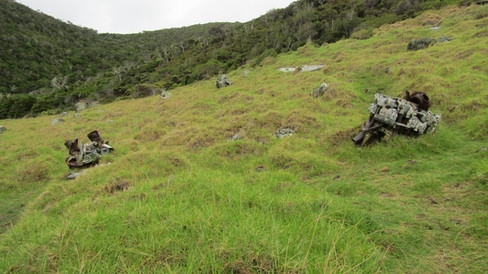Lord Howe Island (2)
- Julie-Anne Justus

- Apr 17, 2024
- 5 min read
Updated: Apr 21, 2024
Mount Gower, the tallest mountain on Lord Howe, is 875m tall, takes eight hours to hike/climb, involves a total walk of 14km, and includes ropes and chains on the trek. We didn't climb Mount Gower (furthest right in photo below) or Mount Lidgbird (to its left), but we did climb Intermediate Hill, the smaller mount-let to Lidgbird's left.

Intermediate Hill is only 250m high but it was a brutal climb. A passing shower made the muddy, slippery path even more muddy and slippery. But we got to the peak.
From the peak of Intermediate Hill, we had a 360 degree view of the island.
Turns out we chose the difficult route to the top. A local told us later that climbing Intermediate Hill from the other side is considerably less brutal.
The lagoon, on the west side of the island, is a calm area protected by the reef. In contrast, the back beaches, those on the east side, are quite rugged and wild. Out in the ocean, 20km southeast, is Ball's Pyramid, the tallest volcanic stack in the world. Apparently it's a great diving spot, though it's tricky to get there even in good weather. It's also famous for being the home of the Lord Howe Island Stick Insect, which was thought to be extinct but rediscovered on Ball's Pyramid in 2001 in a blaze of worldwide glory.
Can you see the pointy blur out in the ocean, through the haze, in the first photo? That Ball's Pyramid seen from Intermediate Hill. Google shows a much better view: https://shorturl.at/euHSY if you're interested in taking a look.
Lord Howe Island has a population of 380 people, and only 400 visitors are allowed on the island at any one time. So tourism is tightly restricted. Flights are limited to two or three Dash-8s a day, each carrying 30 to 40 passengers. Getting a flight and accommodation is a major accomplishment, and you need to book months (or years) out.
The airstrip is right next to the road so it's quite fun stopping to watch the planes land. When the the weather is bad, and it's very windy, the locals park on the side of the airstrip to watch the fun.
Our five-day stay turned into a seven-day stay when our flight off the island to Sydney was cancelled. Even better, in this specific instance Qantas had to pay for our accommodation. Once we had cancelled all our plans back home (not an easy task with no mobile network on the island and minimal wifi at two cafes only), we settled down to enjoy our extra two days, courtesy of Qantas – despite the weather becoming windy and overcast.
The boys headed off to play some more golf but I decided to walk to some of the back beaches. The walk was through kilometres of Kentia palm forests, which are endemic to Lord Howe Island.
Every single Kentia palm (Howea forsteriana – get it?) throughout the world comes from a Lord Howe palm originally. Queen Victoria's enthusiasm for the palms in the 1880s helped them became super-popular in Europe – just as well, as whaling was declining and the island was losing the benefit of supplying the passing trade. The business in Kentia palms boomed. They were everywhere: on the RMS Titanic, in Hollywood movies (they were so popular they were called Hollywood palms) and in hotels (Palm Court, anyone?). You quite possibly have a Kentia palm in your home as they're the most popular indoor palm in the world. Seed from the island is still tightly controlled and is exported mainly to Europe, but we brought back (legally) four tiny seedlings as a souvenir.
Anyhoo, back to my walk. First the Kentia palm forests ...
... then the banyan trees ...
and then the stunning mix of banyans and palms.

There were some steep climbs up and down rocks wound with tree roots. If this had been on the mainland, I would have been terrified of snakes, but Lord Howe Island – that perfect little place – has no snakes. However, somehow, in my quest for bird photos, I strayed from the leaf-covered, barely discernible path and got lost for 45 minutes, wandering through the bush. I wasn't terribly concerned (it's a small island!) but I wondered when the family would send out a search party. They told me later that they would only have started worrying when I didn't turn up for my evening martini, so it's just as well that my strategy #4 worked (backtracking – all earlier strategies had failed; strategy #5 was to start shouting) and I found the path. Or a path. I blame the birds.
The views over the back beaches were impressive but the sea can be pretty wild. A memorial to a 20 year old man who drowned while snorkelling at Middle Beach is a cautionary sign.
A bit more about the island birds. Those that survived the depredations of the First Fleet and the sailors seeking provisions over the years struggled on. Then in 1918, a steamship called the SS Makambo ran aground on Lord Howe Island. With great enthusiasm, black rats from the ship leaped ashore and caused environmental mayhem. The rats ate the Kentia palm seeds (the only commercial export on the island) and caused the extinction of several endemic birds. In an attempt to control the rats, Tasmanian masked owls were introduced, which in turn wiped out some other birds including the smaller native owl. Back to the rat poison ...
Fortunately some birds survived. The most notable of these are the Lord Howe woodhen, also called woodhen rails, endemic to the island. In 1980 the woodhen were almost extinct as a result of the rats and feral pigs, but a breeding program (and the elimination of the pests) has led to a recovery of the population to around 800. They are very persistent around the lodge and around picnics. They are also very vocal at 4 o'clock in the morning. They were the birds I followed into the bush, so at least I have a recording of their sounds to show for my folly.
The buff-banded rail is a more colourful chap than the woodhen, and the emerald dove positively gleams.
What really saved Lord Howe Island was tourism. Tourism started in the 1900s, with visitors coming by ship and disembarking into small boats that took them to the island. After World War 2, the flying boats – the Catalinas – arrived. So glamorous, landing on the water!
In 1948 a RAAF Catalina with nine men on board missed the lagoon during an emergency landing and smashed into Malabar Hill, near Old Settlement Beach. Seven of the nine crew died. The bits of wreckage have been left intact as a memorial. I found it quite moving. Again, it's a bit of a climb to get to the site but the view from the hill is wonderful.
And then it really was time to go home. Au revoir, small and perfectly formed island.






























































































Comments